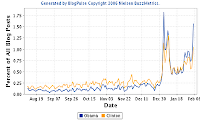
Sentiment Analysis draws on computational linguistic, information retrieval, data mining, natural language processing, machine learning, statistics and predictive analysis to transform unstructured online dialog into marketing insights about companies, products and issues.
Web 2.0 was about collective intelligence; Web 3.0 is about connecting knowledge, making the proliferation of user generated content one of the main drivers behind the emergence of the Sentiment Analysis discipline. Sentiment analysis is on the verge to making eCommerce and Online Advertising a whole lot more efficient.
What are the drivers behind the CGM growth? There is clearly a democratization of revenue share models underway, although being compensated is not a primary driver according to Peter Turner. So, why are users generating content online? Authoring content online has become a basic consumer need of expression, leveraging media fragmentation and device proliferation. Some Internet users just love the attention, educating and influencing, feeling part of a community and creating a dialog. The emergence of social networks' architecture of participation describing systems designed for user contribution, vertical communities, Q&A platforms have accelerated this trend in a significant way. Summize already aggregates over 22 million reviews by over 3 million reviewers. Wikipedia passed 2 million English language articles in September. The blogosphere has been doubling in size every 6 months. YouTube gets about 8 hours of video upload every minute. With increasingly easy to use publishing tools like blogs and RSS feeds, everyone can be an author. Information consumers are becoming producers, driving a significant marketing shift. Marketing is not anymore about "convincing" but about "influence". Recommendations from consumers are trusted by 78% of respondents according to Nielsen.
Traditional advertising is broken. If folks talked to you like TV commercials do, you would punch them in the face! Traditional information sources are facing trust erosion and message dilution challenges. 80% of consumers prefer asking friends or relatives to report on products rather than relying on the brands themselves (PQ Media). 98% of respondents found online reviews credible and 82% have bought at least one product as a result of them (Deloitte). In contrast, 4% highly trust content and opinions from vendors or advertisers. Word-of-mouth is a very powerful selling tool and is generally positive toward brands. PQ Media reports about 3.5 billion brand conversations online each day, making WOM marketing the fastest-growing alternative media segment. Advertising spending will reach $20 billion this year and eCommerce is on track for a $200 billions year. More than 70% of users rely on online reviews. 82% of consumers who read product reviews online, say purchase decisions have been directly influenced by the reviews. 69% of consumers who read reviews, share them, amplifying the impact (Deloitte).
People influence each other’s behavior in many ways, voting, crowd dynamics, following fashions and joining fads. Social influence is particularly relevant to consumer behavior because people aspire to what other people have and rely on other's knowledge and experience. Driving, wearing, reading, listening to the same things builds social identity and promotes cultural cohesion. So, what is the impact of social influence? One in ten Americans tells the other nine what to wear, where to eat and what to buy, according to Keller Fay. Few important trends reach the mainstream without passing through the Influentials in the early stages, and the Influentials can make or break a brand. Brand managers and advertisers already took notice, moving from testing word-of-mouth marketing to including it as a growing component of fully-integrated campaigns. Spending on social media and “conversational marketing” will surpass traditional marketing spending by the end of 2012 according to a TWI Surveys.
Now, no human being can read through this content and make sense of it fast enough. This analysis requires an innovative scientific and technology framework to measure sentiments or opinions expressed in electronic media, combining data gathering with sophisticated entity extraction and real time text analytics to track opinions. Sentiment Analysis is emerging as the definitive brand monitoring platform. Several companies are leading the way with combinations of products and services to support this important area.





No comments:
Post a Comment